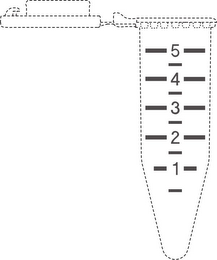Welcome to another edition of newly filed configuration trademark applications at the USPTO, here is the latest; it is quite a specimen:
 The question for the day though is whether the claimed mark actually functions as a trademark to indicate that the goods come from a single source.
The question for the day though is whether the claimed mark actually functions as a trademark to indicate that the goods come from a single source.
The claimed mark is described this way: “The mark consists of a configuration of numbers 1 through 5 situated in a vertical orientation in relation to one another with each number 1 through 4 positioned in the center of four equally opposed horizontal lines and the number 5 positioned in the center of three equally opposed horizontal lines.” It appears that the shape of the sample tube is not being claimed as part of the mark, just the numbers and horizontal lines, given the liberal use of dotted lines.
The claimed goods are described this way: “Plastic disposable products for laboratory use.” First use is claimed back to June 30, 2013, not even two years ago.
Once again, I’m thinking this one will receive a functionality refusal, a lack of distinctiveness refusal, and a failure to function as a trademark refusal . . . .
Back in the day, as a pharmacy student, I worked in several professors labs, and I had the opportunity to handle test tubes, vials, beakers, sample containers, and pipettes, etc.
Many of these types of laboratory items are graduated, meaning they are marked for purposes of rough measurement, even if not highly precise, the markings are still helpful for estimation.
So, what possible purpose or meaning can this configuration of numbers represent beyond estimations of liquid volume measurement?
The specimen of use submitted with the application tells the story: “Eppendorf now offers the >>missing link<<: The Eppendorf Tube 5.0 mL. This product fills the gap between existing tube versions and enables the simple of safe processing of sample volumes up to 5.0 mL.”
Mystery solved, now we know what the numbers mean, big surprise. And just to make sure there are no other mysteries here, mL means milliliter. A thousand of them make a liter. Five of them make a teaspoonful. Oh, and one mL = one cc (cubic centimeter).
Good thing the goods are disposable, because I’m thinking this trademark application is too.
What do you think?
